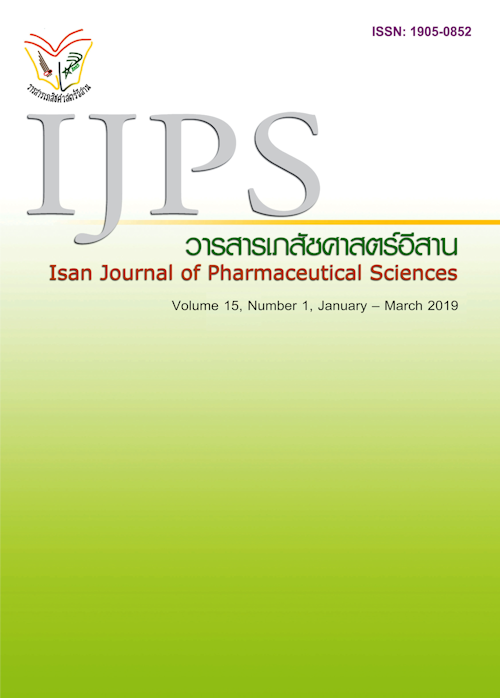Gallic acid ameliorates hypertension, insulin resistance and dyslipidemia in high-fructose diet-induced metabolic syndrome rats
Main Article Content
Abstract
Introduction: Gallic acid is a naturally abundant plant phenolic compound found in vegetables and fruits.It has been shown to have potent antioxidant, antihyperglycemic and antidyslipidemic activities. The present study aims to evaluate the effects of gallic acid on blood pressure, insulin resistance, and dyslipidemia in rats with metabolic syndrome induced by high-fructose diet (HFD). Methods: Male Sprague-Dawley rats were fed with HFD for 18 weeks to induce metabolic syndrome. Oral administration of gallic acid (20 mg/kg/day), metformin (100 mg/kg/day), or vehicle was performed in the last four weeks. Blood pressure, oral glucose tolerance test (OGTT), serum insulin level, HOMA-IR score, and lipid profiles were evaluated. Results: Treatment with gallic acid or metformin significantly reduced blood pressure, serum insulin concentration and HOMA-IR score as well as improved glucose tolerance in HFD-induced metabolic syndrome rats (p < 0.05). In addition, gallic acid or metformin markedly normalized plasma total cholesterol and triglyceride levels (p < 0.05). Conclusion: These findings indicate that gallic acid attenuated signs of metabolic syndrome induced by HFD in rats. It could be suggested that gallic acid supplementation is a beneficial complementary agentfor metabolic syndrome treatment.
Article Details
In the case that some parts are used by others The author must Confirm that obtaining permission to use some of the original authors. And must attach evidence That the permission has been included
References
Ahmed I, Lakhani MS, Gillett M, John A, Raza H. Hypotriglyceridemic and hypocholesterolemic effects of anti-diabetic Momordica charantia (karela) fruit extract in streptozotocin-induced diabetic rats. Diabetes Res Clin Pract 2001; 51(3): 155-161.
Bagul PK, Middela H, Matapally S, et al. Attenuation of insulin resistance, metabolic syndrome and hepatic oxidative stress by resveratrol in fructose-fed rats. Pharmacol Res 2012; 66(3): 260-268.
Bak EJ, Kim J, Jang S, et al. Gallic acid improves glucose tolerance and triglyceride concentration in diet-induced obesity mice. Scand J Clin Lab Invest 2013; 73(8): 607-614.
Erol-Dayi O, Arda N, Erdem G. Protective effects of olive oil phenolics and gallic acid on hydrogen peroxide-induced apoptosis. Eur J Nutr 2012; 51(8): 955-960.
Gandhi GR, Jothi G, Antony PJ, et al. Gallic acid attenuates high-fat diet fed-streptozotocin-induced insulin resistance via partial agonism of PPARgamma in experimental type 2 diabetic rats and enhances glucose uptake through translocation and activation of GLUT4 in PI3K/p-Akt signaling pathway. Eur J Pharmacol 2014; 745(201-216.
Guo H, Ling W, Wang Q, et al. Effect of anthocyanin-rich extract from black rice (Oryza sativa L. indica) on hyperlipidemia and insulin resistance in fructose-fed rats. Plant Foods Hum Nutr 2007; 62(1): 1-6.
Hsu CL, Yen GC. Effect of gallic acid on high fat diet-induced dyslipidaemia, hepatosteatosis and oxidative stress in rats. Br J Nutr 2007; 98(4): 727-735.
Isomaa B, Almgren P, Tuomi T, et al. Cardiovascular morbidity and mortality associated with the metabolic syndrome. Diabetes Care 2001; 24(4): 683-689.
Jin L, Piao ZH, Sun S, et al. Gallic Acid Reduces Blood Pressure and Attenuates Oxidative Stress and Cardiac Hypertrophy in Spontaneously Hypertensive Rats. Sci Rep 2017; 7(1): 15607.
Johnson RJ, Segal MS, Sautin Y, et al. Potential role of sugar (fructose) in the epidemic of hypertension, obesity and the metabolic syndrome, diabetes, kidney disease, and cardiovascular disease. Am J Clin Nutr 2007; 86(4): 899-906.
Kang N, Lee JH, Lee W, et al. Gallic acid isolated from Spirogyra sp. improves cardiovascular disease through a vasorelaxant and antihypertensive effect. Environ Toxicol Pharmacol 2015; 39(2): 764-772.
Kim JH, Park TS, Yang SH, Suh JW, Shim SM. Microbial bioconversion and processing methods enhance the phenolic acid and flavonoids and the radical scavenging capacity of Smilax china L. leaf. J Sci Food Agric 2016; 96(3): 878-885.
Latha RC, Daisy P. Insulin-secretagogue, antihyperlipidemic and other protective effects of gallic acid isolated from Terminalia bellerica Roxb. in streptozotocin-induced diabetic rats. Chem Biol Interact 2011; 189(1-2): 112-118.
Majithiya JB, Balaraman R. Metformin reduces blood pressure and restores endothelial function in aorta of streptozotocin-induced diabetic rats. Life Sci 2006; 78(22): 2615-2624.
Matthews DR, Hosker JP, Rudenski AS, Naylor BA, Treacher DF, Turner RC. Homeostasis model assessment: insulin resistance and beta-cell function from fasting plasma glucose and insulin concentrations in man. Diabetologia 1985; 28(7): 412-419.
Oron-Herman M, Kamari Y, Grossman E, et al. Metabolic syndrome: comparison of the two commonly used animal models. Am J Hypertens 2008; 21(9): 1018-1022.
Palanisamy N, Venkataraman AC. Beneficial effect of genistein on lowering blood pressure and kidney toxicity in fructose-fed hypertensive rats. Br J Nutr 2013; 109(10): 1806-1812.
Prabhakar P, Reeta KH, Maulik SK, Dinda AK, Gupta YK. Protective effect of thymoquinone against high-fructose diet-induced metabolic syndrome in rats. Eur J Nutr 2015; 54(7): 1117-1127.
Punithavathi VR, Prince PS, Kumar R, Selvakumari J. Antihyperglycaemic, antilipid peroxidative and antioxidant effects of gallic acid on streptozotocin induced diabetic Wistar rats. Eur J Pharmacol 2011a; 650(1): 465-471.
Punithavathi VR, Stanely Mainzen Prince P, Kumar MR, Selvakumari CJ. Protective effects of gallic acid on hepatic lipid peroxide metabolism, glycoprotein components and lipids in streptozotocin-induced type II diabetic Wistar rats. J Biochem Mol Toxicol 2011b; 25(2): 68-76.
Suwannaphet W, Meeprom A, Yibchok-Anun S, Adisakwattana S. Preventive effect of grape seed extract against high-fructose diet-induced insulin resistance and oxidative stress in rats. Food Chem Toxicol 2010; 48(7): 1853-1857.
Tai MM. A mathematical model for the determination of total area under glucose tolerance and other metabolic curves. Diabetes Care 1994; 17(2): 152-154.
Zimmet P, Alberti KG, Shaw J. Global and societal implications of the diabetes epidemic. Nature 2001; 414(6865): 782-787.


